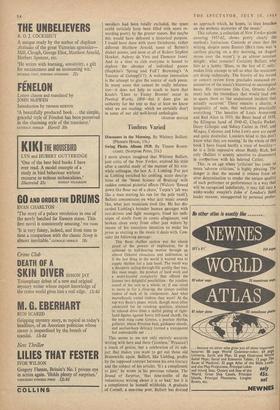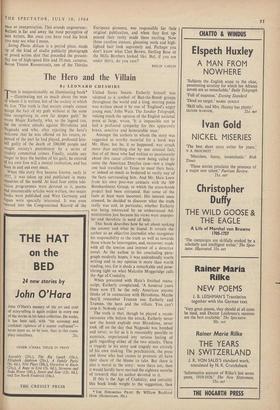Timbres Varied
I HAVE always imagined that Whitney Balliett, jazz critic of the New Yorker, evolved his style after a careful study of the manner of his erst- while colleague, the late A. J. Liebling. For just as Liebling enriched his ambling, acute descrip- tions of the 'Sweet Science of Bruising' with sudden comical pictorial effects (Walcott 'flowed down like flour out of a chute,' Turpin's 'jab was like a man starting his run for the pole vault'), Balliett concentrates on what jazz music sounds like, what jazz musicians look like. He has dis- carded Liebling's broader human passages with taxi-drivers and fight managers, freed his tech- nique of simile from its comic allegiances, and broken clean away from other jazz writers by reason of his conscious intention to make his prose as exciting as the music it deals with. Con- sider the following passage:
This Basic rhythm section was the classic proof of the powers of implication, for it achieved its ball-bearing motion through an almost Oriental casualness and indirection, as if the last thing in the world it wanted was to supply rhythm for a jazz band. The result was a deceptive sailing-through-life quality that was, like most magic, the product of hard work and a multi-layered complexity that offered the listener two delightful possibilities: the jointless sound of the unit as a whole, or, if one cared to move in for a close-up, the always audible timbre of each of its components. And what marvellously varied timbres they were! At the top was Basic's piano, which, though most often celebrated for its raindrop qualities, attained its relaxed drive from a skilful pitting of right- hand figures against heavy left-hand chords. On the next rung came Greene, a peerless rhythm guitarist, whose Prussian beat, guidepost chords, and aeolian-harp delicacy formed a transparent but unbreakable net . . .
This seems to me not only entirely accurate writing with here and there ('jointless,"Prussian) a touch of genius, but a celebration of its sub- ject that makes you want to get out those old Brunswicks again. Balliett, like Liebling, profits by the supposed contrast between his own literacy and the subject of his articles. 'It's a compliment to jazz,' he wrote in his previous volume, The Sound of Surprise, 'that nine-tenths of the voluminous writing about it is so bad,' but it is a compliment he himself withholds. A graduate of Cornell, a one-time poet, Balliett has devised an approach which, he hopes, 'at least breathes on the Festhetic mysteries of the music.'
This volume, a collection of New Yorker pieces covering 1957-62, shows pretty clearly the method's limitations. Concede at once that the writing, despite some floaters (Bix's tone was 'a carillon playing on a dry morning, an August moon over the water'), is an almost constant delight: what remains? Certainly Balliett, who lists as a hobby 'Blues, in the key of C only,' makes little attempt to tell us what the musicians are doing technically. The brevity of his record or concert review form precludes sustained ex- amination of the music's historical or sociological bases. His interviews (Ida Cox, Ornette Cole- man) lack the immediacy tint would lead one to quote them as 'the undoctored incident that actually occurred.' There remains a charity, a hospitality of taste, that welcomes practically everything. 'The beauties of Louis Armstrong and Red Allen in 1933, the Basie band of 1938, the Ellington band of 1940-42, Charlie Parker, Dizzy Gillespie and Sidney Catlett in 1945, and Mingus, Coleman and John Lewis now are equal and quite dissimilar. Listeners blind to this don't know what they are missing.' In the whole of this book I have found hardly a trace of hostility— he is a little repressive about Buddy Rich, but only (Balliett is acutely sensitive to drummers) in con1parison with his beloved Catlett.
This, in an age where 'criticism' has come to mean 'adverse criticism,' is highly pleasing. The danger is that the second it relaxes from an utter determination to render the unique quality of each performer or performance in a way that will be recognised indefinitely, it may fall into a wishy-washy essayist's John o' London's third leader manner, unsupported by personal prefer -
ence or interpretation. This sounds ungenerous: Halliett is far and away the most perceptive of jazz writers. But once you have read his book You may see what I mean.
Swing Photo Album is a period piece, made Up of the kind of studio publicity photograph or posed action shot that preceded the present- day use of high-speed film and 35-mm. cameras. 13aron Timme Rosencrantz, one of the Thirties
European pioneers, was responsible for their original publication, and when they first ap- peared their rarity made them exciting. Now those carefree stances, gleaming teeth and high- lighted hair look supremely sad. Perhaps you don't know what Cleo Brown, Sterling Bose or the Mills Brothers looked like. But, if you are under thirty, do you care?
PHILIP LARKIN











































 Previous page
Previous page